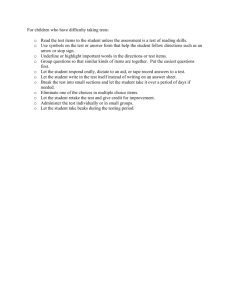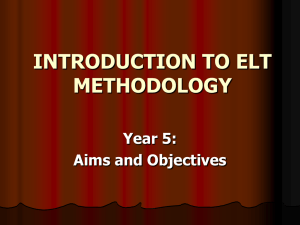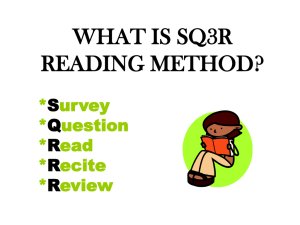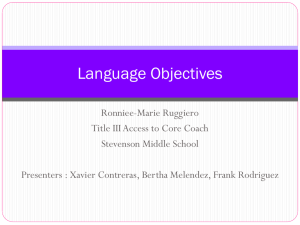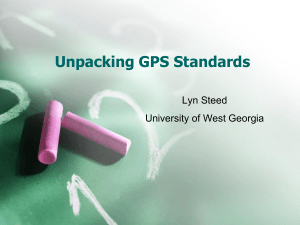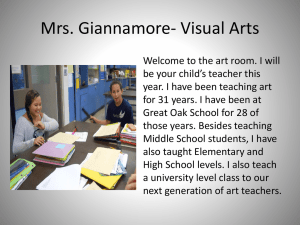Sample Language and Content Objectives Map
advertisement
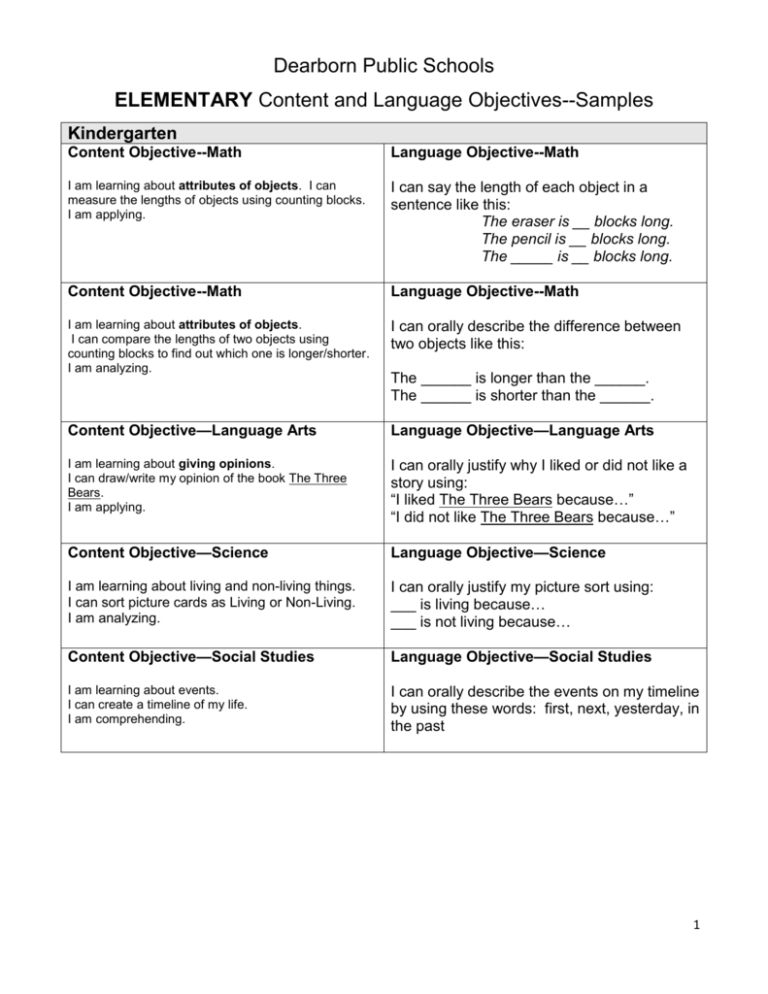
Dearborn Public Schools ELEMENTARY Content and Language Objectives--Samples Kindergarten Content Objective--Math Language Objective--Math I am learning about attributes of objects. I can measure the lengths of objects using counting blocks. I am applying. I can say the length of each object in a sentence like this: The eraser is __ blocks long. The pencil is __ blocks long. The _____ is __ blocks long. Content Objective--Math Language Objective--Math I am learning about attributes of objects. I can compare the lengths of two objects using counting blocks to find out which one is longer/shorter. I am analyzing. I can orally describe the difference between two objects like this: Content Objective—Language Arts Language Objective—Language Arts I am learning about giving opinions. I can draw/write my opinion of the book The Three Bears. I am applying. I can orally justify why I liked or did not like a story using: “I liked The Three Bears because…” “I did not like The Three Bears because…” Content Objective—Science Language Objective—Science I am learning about living and non-living things. I can sort picture cards as Living or Non-Living. I am analyzing. I can orally justify my picture sort using: ___ is living because… ___ is not living because… Content Objective—Social Studies Language Objective—Social Studies I am learning about events. I can create a timeline of my life. I am comprehending. I can orally describe the events on my timeline by using these words: first, next, yesterday, in the past The ______ is longer than the ______. The ______ is shorter than the ______. 1 First Grade Content Objective—Language Arts Language Objective—Language Arts I am learning about opinions. I can sort opinions and non-opinions. I am analyzing. I can orally explain why a statement is an opinion using: _____ is an opinion because … or _____ is not an opinion because… Language Objective—Language Arts Content Objective—Language Arts I am learning about writing an opinion piece. I can list my choice for a class pet and adding two supporting reasons. I am applying. I can orally rehearse my opinion using my notes in a “Talking Paragraph” using: Prompt: Which pet should our class adopt? Our class should adopt a.... One reason is.... Another reason is.... Content Objective—Science Language Objective—Science I am learning about animals. I can list what I know about polar bears. I am remembering. I can rewrite my science words about polar bears on my ABC personal word wall. Content Objective—Science Language Objective—Science I am learning about animals. I can write a letter about polar bears living in the Arctic. I am synthesizing. I can orally discuss one key point using academic words from my writing. Content Objective—Social Studies Language Objective—Social Studies I am learning about goods and services. I can label a picture with the words: producers, consumers, goods, services, money. I am comprehending. Content Objective—Math I can orally define goods and services with my partner using these sentence stems: I am learning about attributes of objects. I can distinguish: closed or unclosed sides, number of sides, color and size. I am analyzing. I can orally compare the difference between two objects like this: This is a picture of _______. It means… This is a picture of _______. We use this… Language Objective—Math This object has ___ sides while this object has ___ sides. This object is the color ____ and has ___ sides. This object is also the color ___ but it has ____ sides. 2 Second Grade Content Objective--Science Language Objective--Science Students will demonstrate knowledge of the phases of the water cycle by labeling the phases on a visual representation. I can orally describe the three phases using: Evaporation is when… Condensation happens because… Examples of precipitation include… Content Objective--Science Language Objective--Science I can demonstrate application of the phases of the water cycle by building a model to show each phase of the water cycle. I can write to explain how the water cycle works using the words: precipitation, condensation, evaporation Content Objective—Science Language Objective--Science I can demonstrate knowledge of the properties of matter by recognizing and listing the observable attributes (color, shape, size, texture) of everyday objects on a circle map. I can orally describe the object using: The color of __________ is.. The size of ___________ is… The shape of _________ is… Content Objective—Science Language Objective—Science I can demonstrate analysis of the properties of matter by comparing and contrasting the characteristics of different objects on a double bubble map. (color, size, shape, texture, hardness, liquid/solid, sinking/floating) I can write to compare two objects using: One similarity between __ and __ is… Another way __ and __ are similar is… Content Objective—Social Studies Language Objective—Social Studies I can demonstrate comprehension of physical and human characteristics of a community by sorting examples on a T-chart. I can orally explain the difference between physical and human characteristics using: One way they are different is that... __ is… but __ is… A ________ is a physical/human characteristic because… Content Objective—Social Studies Language Objective—Social Studies I can demonstrate comprehension of answering the question “What are some characteristics of this community?” by reading Michigan and identifying human and physical characteristics. I can orally share about the community I read about by saying: “I read about…” “Some human characteristics of this community are…” “Some physical characteristics of this community are…” 3 Third Grade Content Objective—Language Arts Language Objective—Language Arts I can demonstrate application of asking questions by generating who, what, where, when, why, and how questions during reading. I can orally explain whether my question supports my understanding of the text ___________using the stem: Content Objective—Language Arts Language Objective—Language Arts I can demonstrate comprehension of describing characters by listing words and phrases from the first three chapters that describe Charlotte and Wilber on a modified circle map I can write 2-3 sentences describing each character (Charlotte & Wilber) using the stems: Content Objective—Math Language Objective—Math I can demonstrate comprehension of shapes and their attributes by defining and visually representing a rhombus, a rectangle and a square on a 4-square vocabulary chart. I can orally explain the attributes of a rhombus, a rectangle and a square using the frames: Content Objective—Math Language Objective—Math I can demonstrate application of shapes and their attributes by constructing examples of a square, rectangle and a rhombus using a ruler and a compass. I can orally and in writing compare and contrast the attributes of a rectangle and a rhombus to a square using the frames: “This question helps me understand the story because….” “This question does NOT help me understand the story because….” I would describe Charlotte/Wilbur as ________. I know this because in the story…… A _________ has __ sides. A _________ has __ vertices. The angles of _________ are… The sides of _________ are… A square and a rectangle both have…. A square has ___ but a rectangle has ____ . A square and a rhombus both have… A square has ___ however a rhombus has ___. Content Objective—Social Studies Language Objective—Social Studies I can demonstrate application of developing a topic by comparing and contrasting the UP and LP on a double bubble map (economy, geography, population) I can write to compare the UP and LP using: One similarity between the UP and the LP is… Another way the UP and LP are similar is… One way they are different is that the UP... However, the LP… Furthermore, the UP…. In contrast, the LP… 4 Fourth Grade Content Objective—Language Arts Language Objective—Language Arts I can demonstrate comprehension of writing an opinion piece by organizing the parts of an opinion piece using cut-up paragraphs. I can orally explain the purpose of each part of an opinion piece using the frames: Content Objective—Language Arts/Social Studies Language Objective—Language Arts/Social Studies I can demonstrate application of writing an opinion piece about the impact of immigration on the United States by drafting a paragraph that includes: Topic sentence with an opinion 3 supporting facts and/or details Concluding statement (strongest point!) I can listen to explain the organizational structure of my partner’s opinion using the frames: Content Objective—Language Arts Language Objective—Language Arts I can demonstrate analysis of distinguishing fact from opinion in informational text by highlighting examples of facts and/or opinions in a sample advertisement. I can orally explain how they distinguished a fact from an opinion by completing the frame: Content Objective—Social Studies Language Objective—Social Studies I can demonstrate analysis of the impact of immigration to the US by reading “Who Belongs Here? An American Story” and “Don’t Shut the Golden Door” and identifying influences on food, shelter, schooling, jobs, crime etc. on a graphic organizer. I can orally explain the impact of immigration using the frames: Content Objective—Math Language Objective—Math I can demonstrate application of word problems involving multiplication of a fraction by a whole number by using visual fraction models. I can orally explain my visual fraction model of a word problem to my partner using these words: multiply, fraction, numerator, parts, denominator, whole, represent, number line, pie chart, real question, answer This statement is part of the ___ in an opinion piece. Its purpose is to… This part of the opinion piece tells the reader… My partner introduced the topic by… The supporting facts/details are… The linking words used to connect the reasons are… A fact in this advertisement is… An opinion in this advertisement is… The words that make this statement a fact/opinion are … The author __ states…however __ states that…. The authors are in agreement that… Positive effects of immigration included in both texts are… Some of the negative effects mentioned in the texts are… 5 Fifth Grade Content Objective—Language Arts/Science Language Objective—Language Arts/Science I can demonstrate comprehension of the author’s evidence to support points in Hurricanes by making inferences about the role that “changes in air pressure” play in creating a hurricane. I can orally explain to a partner how changes in air pressure creates hurricanes using specific annotations and the words: air, pressure, hot/cold, winds Content Objective—Language Arts/Science Language Objective—Language Arts/Science I can demonstrate application of writing a news article by summarizing important information about the formation of hurricanes I can orally discuss with my coauthor the formation of hurricanes using the academic language: air pressure, strong winds, atmosphere, moisture, temperature Content Objective—Language Arts Language Objective—Language Arts I can demonstrate comprehension of explicit text and inferences by organizing ideas from Tuck Everlasting on a T chart. I can write one accurate quote to support each: an explicit idea and an inference for chapter 3 using the sentence frames: On page _, the author writes, “….” that tells me…. (explicit) On page _, the author writes, “….” that makes me think….(inference) Content Objective—Social Studies Language Objective—Social Studies I can demonstrate analysis of the roles and responsibilities of the three branches of government by comparing and contrasting the three branches on a Venn Diagram I can orally explain how the three branches are similar and different using complex sentences such as: One similarity/difference between the ___ and ___ branches is… The similarities/differences are significant because… Content Objective—Science Language Objective—Science I can demonstrate comprehension of the traits of organisms that help them survive in their environment by describing these physical characteristics on a tree map. I can orally describe physical characteristics of an animal that help it survive in its environment using this sentence stem: “One way that a ________ can survive in the _________ is by…” 6 SECONDARY Content and Language Objectives--Samples Topic Content Objective Language Objective Physics Students will demonstrate analysis of a motor and generator by comparing and contrasting on a double bubble map. I can orally describe the similarities and differences between a motor and a generator using these vocabulary words: electric current, permanent magnet, movable coil, armature, and voltage source. Biology I can demonstrate analysis of Meiosis I and Meiosis II by comparing and contrasting using a double bubble map. I can write a 2 paragraph summary to compare and contrast Meiosis I and Meiosis II using these sentences: “The similarity between Meiosis I and Meiosis II is …” “The differences between Meiosis I and Meiosis II is …” Biology Students will demonstrate comprehension of hemostasis by summarizing information in a 12-minute research paper. Students will read and write to explain the mechanism of hemostasis using a structured paragraph: “One thing I learned is …. Another new thing I learned is …I thought page ____ was interesting because … It made me think of …” United States History I can demonstrate comprehension of the contemporary United States by recognizing 4-6 important events using a concept map. I can orally explain contemporary U.S. events using these vocabulary words: surge, budget, career, explosive, apartheid, sanction, deficit, poll, literally United States History I can demonstrate analysis of the Preamble to the Constitution by deconstructing each line using a vocabulary map. I can orally explain the Preamble using these vocabulary words: ordain, posterity, justice, tranquility, union, welfare Economics I can demonstrate comprehension of the law of supply by constructing a supply schedule and supply curve. I can draw and label a supply curve using these vocabulary words: quantity, price, decrease in supply 7 World History I can demonstrate analysis of impacts of the war on the soldiers and people at home by distinguishing examples of censorship using primary source letters. I can orally deconstruct with a partner a primary source letter using these sentence stems: “One example of censorship is … Another example is … The reason these statements would be censored is …” Government I can demonstrate knowledge of the goals of a political party by creating a campaign poster for a presidential candidate. I can orally describe a political party and it’s goals by presenting a 2 minute speech using this structure: Language I can demonstrate comprehension of the short story The Interlopers by identifying types of conflict using a brace map. I can write a paragraph describing 2 conficts from The Interlopers using these stem stems: Students will demonstrate comprehension (f parts of a narrative by identifying the setting, characters, and sequence of events on a flow map. Students will write a three paragraph narrative that includes a beginning (Introduction), middle (Supporting details) and end (Conclusion). Students will demonstrate evaluation of distinguishing fact from opinion by identifying which statements are fact and which are opinion on a T-Chart. Students will orally distinguish fact from an opinion by justifying one fact and one opinion using complex sentences: Arts Language Arts Language Arts Introduction to Party Platform, 3 goals of the party, 2 changes that differ from the opposition, compelling concluding statement “One conflict from The Interlopers is …. The evidence is …Another conflict is … because … ________ is a fact/opinion. I am confident in my decision because….. The key words that I used to decide are… Math Students will demonstrate knowledge of the equivalency among decimals, fractions, and percents by matching given numbers in a mix, match and freeze activity. Students will orally present and explain the equivalency among decimals, fractions, and percents to the class using the words: decimal, fraction and percent. 8 Math Students will demonstrate application of word problems to create equations in two variables by using the GUESS strategy on a flow map. Students will discuss with a partner how they used the GUESS strategy to solve equations using the sentence stem: The GUESS strategy helped me to … Math Students will demonstrate application of Students will orally explain how they finding the area of triangles by using the determined the area of triangles using formula A=½ bh to find the area right the words: base, height and area. triangles, isosceles and equilateral. Math Students will demonstrate Students will orally explain the attributes comprehension of shapes and their of a rhombus, a rectangle and a square attributes by defining and visually using the frames: representing a rhombus, a rectangle and A _________ has __ sides. a square on a 4-square vocabulary chart. A _________ has __ vertices. The angles of _________ are… The sides of _________ are… 9

